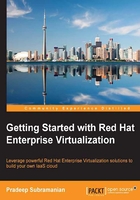
What this book covers
Chapter 1, An Overview of Red Hat Enterprise Virtualization, gives you a basic introduction to RHEV, its internal architecture and components, and the basic hardware and software prerequisites.
Chapter 2, Installing RHEV Manager and Hypervisor Hosts, shows you how to set up and configure the RHEV Manager and access the web-based admin portal, install and configure RHEV's hypervisor hosts, and install and connect to the report portal in order to report scenarios of your virtual infrastructure's resource usage.
Chapter 3, Setting Up the RHEV Virtual Infrastructure, shows you how to create a virtual data center and cluster, add the hypervisor host to cluster, configure storage, and perform networking.
Chapter 4, Creating and Managing Virtual Machines, shows you how to create virtual machines, templates, derive virtual machines from the template, take live snapshots of virtual machines, and back up and restore of virtual machines using export and import disks.
Chapter 5, Virtual Machine and Host High Availability, shows you how to set up the virtual machine host availability, various cluster policies for cluster hosts, and perform live migration of virtual machines.
Chapter 6, Advanced Storage and Networking Features, briefs you about various storage disks options, such as sharing disks across virtual machines, direct LUN mapping from the storage, moving virtual machines across different storage domains, shaping the network traffic's VNIC profile for guest operating systems, and hot plugging of network adapter and memory into virtual machines.
Chapter 7, Quota and User Management, talks about applying quota to your virtualization infrastructure with user-role-based access control and integration with common directory services.
Chapter 8, Managing a Virtualization Environment from the Command Line, shows you how to set up the command-line tools in order to manage your virtualization infrastructure other than the standard RHEV Manager web-based interface.
Chapter 9, Troubleshooting RHEV, talks about various logfiles of the RHEV manager and hypervisor hosts and provides you with steps to put your RHEV virtualization infrastructure into maintenance mode for any planned outage.
Chapter 10, Setting Up iSCSI, NFS, and IdM Directory Services for RHEV, shows you how to set up your Red Hat Enterprise Linux server as an iSCSI, the NFS storage server for RHEV virtual machine data storage, the ISO library to store ISO, and export the domain to export the virtual machine for backup and restoration, and set up and configure IdM directory services on RHEL to integrate RHEV with the Red Hat IdM directory service for user management.
Appendix shows you how to upgrade RHEV environment from Version 3.3 to 3.4. This chapter is available as a bonus chapter and can be downloaded from https://www.packtpub.com/sites/default/files/downloads/7402OS_Appendix.pdf.